|
Who Made It?
The Campbell & Smith Company began
in 1892, and it was primarily a lumberyard and planing mill. Lebanon is
the county seat of Boone County, Indiana, and Campbell-Smith-Ritchie
named its Hoosier-style kitchen cabinets Boone Kitchen Cabinets in honor
of the county. In 1905, the lumberyard was destroyed by fire. The
company built a new facility on the edge of town. By 1910, its kitchen
cabinet making business was doing so well that the lumberyard portion of
the business was discontinued. An Indiana inspection report for 1913
described the company as engaged in manufacturing furniture and having
90 employees. It was also the largest employer inspected in Lebanon.
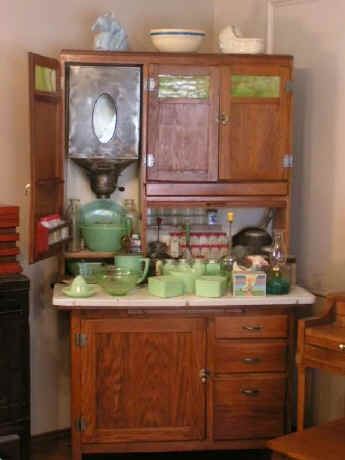 The
company advertised nationally, and claimed its product was designed by
women from all over the nation. Models of Boone cabinets were
differentiated with names such as the Mary Boone, Bertha Boone, a larger
model with storage closets at each end and Betty Boone, a small model
for apartments or smaller homes. Some included a hidden ironing board.
The company, like many companies, prospered until the Great Depression.
Demand for Hoosier cabinets declined at the time, first because of the
difficult economic times, but also because homes began to be built with
built–in cabinetry in the kitchen. The company responded by cutting
back on employee hours and diversifying into built-in kitchen cabinets
and breakfast dining sets. This strategy enabled it to survive into 1940
when it was sold. The company continued for another 18 months, but was
then liquidated. The
company advertised nationally, and claimed its product was designed by
women from all over the nation. Models of Boone cabinets were
differentiated with names such as the Mary Boone, Bertha Boone, a larger
model with storage closets at each end and Betty Boone, a small model
for apartments or smaller homes. Some included a hidden ironing board.
The company, like many companies, prospered until the Great Depression.
Demand for Hoosier cabinets declined at the time, first because of the
difficult economic times, but also because homes began to be built with
built–in cabinetry in the kitchen. The company responded by cutting
back on employee hours and diversifying into built-in kitchen cabinets
and breakfast dining sets. This strategy enabled it to survive into 1940
when it was sold. The company continued for another 18 months, but was
then liquidated.
The Coppes Brothers and Zook
Company decided to concentrate on kitchen cabinets in 1914. Their
manufacturing facility was located in Nappanee, Indiana, and their
Hoosier cabinet brand name was the Napanee Dutch Kitchenet, using only
one p in Nappanee. Using data from a study by a famous efficiency
engineer, Harrington Emerson, the company claimed that their product
could save 1,592 steps per day.
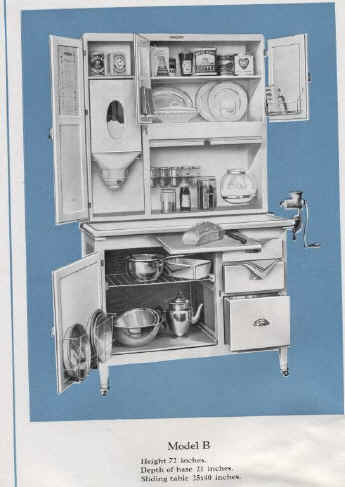 Earlier,
the Coppes brothers had a sawmill business, a box manufacturing factory,
and a furniture manufacturing company. An Indiana inspection report for
1913 described their company, named Coppes, Zook, and Mutschler Co. at
that time, as a "saw mill, etc." and having 178 employees in a
town with a population of 2,260. Right before the Great Depression
started, the company began manufacturing built-in kitchen cabinets. This
product was very successful, and continued for many years after the
demise of the Hoosier cabinets. Production of high-quality custom
cabinetry continues today and Coppes Brothers and Zook is the
longest-continuously-operating cabinet manufacturer in the United
States. Earlier,
the Coppes brothers had a sawmill business, a box manufacturing factory,
and a furniture manufacturing company. An Indiana inspection report for
1913 described their company, named Coppes, Zook, and Mutschler Co. at
that time, as a "saw mill, etc." and having 178 employees in a
town with a population of 2,260. Right before the Great Depression
started, the company began manufacturing built-in kitchen cabinets. This
product was very successful, and continued for many years after the
demise of the Hoosier cabinets. Production of high-quality custom
cabinetry continues today and Coppes Brothers and Zook is the
longest-continuously-operating cabinet manufacturer in the United
States.
The Hoosier Manufacturing Co.
began in Albany, Indiana in the year 1898. The founders were glassmaker
James McQuinn, his son Emmett McQuinn, and two business partners from
Muncie, Indiana, John M. Maring and Thomas Hart. Maring and Hart served
as the president and vice president, respectively. The two McQuinns ran
the business, with the elder McQuinn as the plant's general manager. The
younger McQuinn was the advertising manager. Originally, the company
used a former furniture manufacturing plant to make a seed separator
used on farms. A secondary product, a stand-alone kitchen cabinet, sold
better than the seed separator and quickly became the company's main
product. Each of the early Hoosier Cabinets was hand–made. The cabinet
was similar to a baker's cabinet, with storage bins below a work space
and a two-door upper section. However, the Hoosier Cabinet had
"meticulously organized interior storage", which enabled it to
serve as a kitchen workstation with all the necessary equipment and
material within arm's reach.
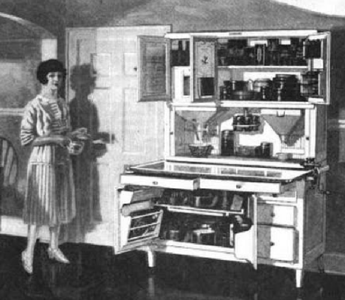 The
company's Albany facility was destroyed by a fire in 1900. At that time,
the owners decided to restart in New Castle, Indiana, which is located
about 25 miles south of Albany. The
company's Albany facility was destroyed by a fire in 1900. At that time,
the owners decided to restart in New Castle, Indiana, which is located
about 25 miles south of Albany.
In addition to its product, Hoosier
Manufacturing's success can be attributed to its strengths in
advertising, distribution, and manufacturing. Hoosier Manufacturing
created its own dealer network, since some furniture dealers were not
fond of a product that competed with their wares. In cases where they
had no dealer, products were sold directly from the factory. Advertising
was conducted in newspapers and national magazines such as Ladies'
Home Journal and The Saturday Evening Post, where the reader
was likely to be a woman. In 1903, the company began streamlining its
manufacturing process by using interchangeable hardware, standardizing
its products, and using an assembly line. The employee responsible for
these innovations, Harry Hall, was also granted patents related to
innovations for the cabinet and for a safety apparatus.
By 1913, Hoosier Manufacturing, listed
as a furniture maker by Indiana factory inspectors, had 470 employees.
In 1916, the company sold its one millionth Hoosier Cabinet and was
clearly the leader in free-standing kitchen cabinets. By 1920, two
million had been sold. During its peak years, the company produced
nearly 700 cabinets per day, and was the largest manufacturer of kitchen
cabinets in the United States.
Free–standing kitchen cabinets began
declining in popularity by 1930, and Hoosier Manufacturing responded by
making kitchen cabinets that were meant to be built-in to the home. The
company also began manufacturing kitchen tables and breakfast sets.
During World War II, supplies and man-power became scarce. The company
was sold and liquidated in 1942.
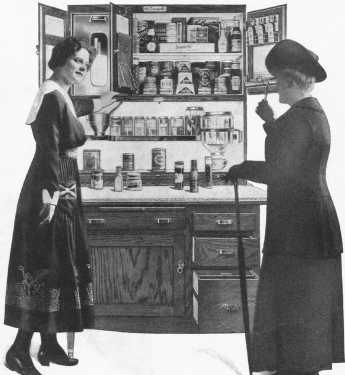 McDougall
was one of the early manufacturers of Hoosier cabinets. An advertisement
from 1919 identified the McDougall as "the first kitchen
cabinet". George McDougall began the McDougall Company in
Indianapolis, Indiana, sometime after the Civil War. The company's
products were pie safes and kitchen tables. In 1898, the company name
was changed to G. P. McDougall and Son. George's son Charles traveled to
learn more about the furniture business, and persuaded his father to
equip their kitchen tables with flour bins, a product that eventually
became known as a baker's cabinet. Charles also traveled to Europe and
the European influence can be seen on McDougall cabinets. In 1909, a
disgruntled employee set the factory on fire, destroying the entire
facility. McDougall
was one of the early manufacturers of Hoosier cabinets. An advertisement
from 1919 identified the McDougall as "the first kitchen
cabinet". George McDougall began the McDougall Company in
Indianapolis, Indiana, sometime after the Civil War. The company's
products were pie safes and kitchen tables. In 1898, the company name
was changed to G. P. McDougall and Son. George's son Charles traveled to
learn more about the furniture business, and persuaded his father to
equip their kitchen tables with flour bins, a product that eventually
became known as a baker's cabinet. Charles also traveled to Europe and
the European influence can be seen on McDougall cabinets. In 1909, a
disgruntled employee set the factory on fire, destroying the entire
facility.
Charles McDougall, with several
business partners, restarted the business in Frankfort, Indiana, in
1910. The company was named McDougall Company, and Hoosier cabinets were
its product. The plant utilized the latest technology for furniture
manufacturing. The McDougall Hoosier cabinet had a patented auto-front
roll door that dropped down instead of rolling up. Its flour bin had a
glass front to show the flour level in the bin. In 1913, the McDougall
plant had 148 employees, making it the largest factory in Frankfort,
based on the number of employees.
Near the end of the 1920s, the
McDougall cabinets front door was changed to be similar to those used by
other Hoosier cabinets. Its flour bins were made smaller. The Great
Depression was difficult. The company was reorganized in 1931. The
company lasted a few years before closing.
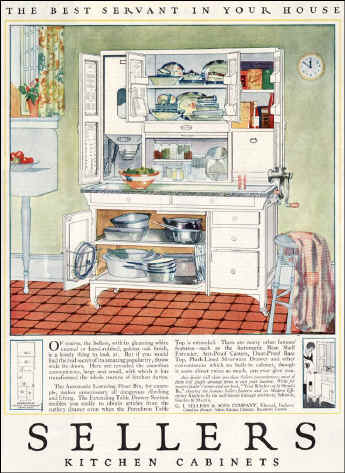 The
G. I. Sellers Company was founded in Kokomo,
Indiana, in 1888. The company made chifforobes, cabinets, and tables,
and oak was their choice material. They grew to become the second
largest manufacturer of Hoosier cabinets. By 1905, their manufacturing
complex covered five city blocks. During that year, their plant was
destroyed by fire. In order to restart their business as soon as
possible, the company purchased a furniture factory in Elwood, Indiana.
At that time, the company name was changed to the G. I. Sellers and Sons
Company, and manufacturing was focused on Hoosier cabinets and tables. The
G. I. Sellers Company was founded in Kokomo,
Indiana, in 1888. The company made chifforobes, cabinets, and tables,
and oak was their choice material. They grew to become the second
largest manufacturer of Hoosier cabinets. By 1905, their manufacturing
complex covered five city blocks. During that year, their plant was
destroyed by fire. In order to restart their business as soon as
possible, the company purchased a furniture factory in Elwood, Indiana.
At that time, the company name was changed to the G. I. Sellers and Sons
Company, and manufacturing was focused on Hoosier cabinets and tables.
By 1913, the Sellers plant employed 99
people, making it the second largest factory, based on the number of
employees, in Elwood. Among features Sellers promoted were an automatic
lowering flour bin, glass drawer pulls, hand-rubbed finish on oak, and
ant-proof casters. The company initiated a "Votes for Women"
contest for little girls in 1914. Prizes were Junior Special Kitcheneed
Cabinets, which were two–thirds the size of the Sellers Kitcheneed
Special.
In 1922, Wilfred Sellers, the company
president, noted that the company typically produced 75,000 to 85,000
cabinets per year. Sellers introduced its Kitchenaire models in 1927,
which had smaller flour bins but more drawers. In the early 1930s,
coloring was featured, and new products were sold such as built-in
kitchen cabinets and breakfast sets. By the 1930s, Hoosier cabinets had
fallen out of fashion, and most manufacturers had stopped making them.
The Sellers Co. continued building the cabinets, however, and the
company's later designs were given sleek lines and curves that tried to
tap into the art deco fashion of the day. During World War II, the
company had difficulty acquiring raw materials and employing skilled
workers. It ceased operations in 1950.
|